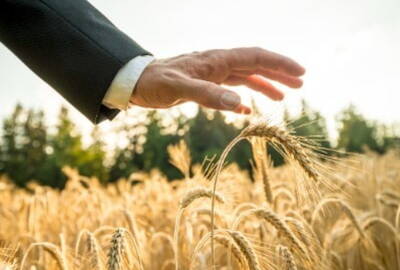It’s no secret that the world needs to produce more food while using fewer resources. Many believe AI holds the key to unlocking a new agricultural revolution. In this article, we explore a number of ways the future of farming could be impacted by innovations in this space.
Traditional farming methods alone are not enough to remain competitive in the current climate. According to the latest UN statistics, the global population is predicted to rise by 2 billion within the next 30 years, meaning the demand for food is only going to rise.
Throughout all areas of the chain, including support with seasonal planning, planting, protection, harvest, and trading crops, AI is becoming a driving force for innovation and new business models across all sectors.
1. Improving Crop Yield Predictions
Both Machine Learning and AI can be used to help enhance crop predictions. Using a combination of drone technology and smart sensors, agricultural specialists can review real-time information pertaining to on-the-ground data, growing patterns, nutrient levels, moisture, and more.
AI delivers on the ability to combine huge datasets and provide optimal guidance for crop yields at-scale.
2. Monitoring Livestock Health
Livestock health is vital, and understanding the optimal conditions of boarding and diet can help farmers maximise their yield and profits. Machine Learning and AI both provide vital insights into the daily activity levels, vital signs, and uptake of food from their livestock.
3. Surveillance over extensive areas of land
By utilizing AI-based surveillance, real-time footage can provide immediate alerts to human and animal breaches. This decreases the risk of extensive damage or loss caused by people or animals in remote or expansive locations. This technology can be applied to both small and large-scale farming operations.
4. Yield Mapping for Optimal Crop Planning
This is another technique that is fast becoming dependant on Machine Learning. Prior to any vegetation cycle is started, it is now possible to know yield rate potential using drones and AI. Through a meticulous process of 3D mapping and the collection of data from drones and sensors, agricultural experts can accurately make informed predictions about soil yields for a specific type of crop.
5. Automated Fertilizer Distribution
Many agricultural businesses across the globe still struggle to find workers for their agriculture jobs, particularly in remote locations. Many of you will already have heard about agri-bots, smart-tractors, and other robotics being used in the agriculture sector; these machines are helping large-scale firms who cannot fill their farming jobs stay on-top of their labour needs. This equipment means that farmers can get coverage across many hundreds of acres in a cost-effective way. They can be pre-programmed to automate the distribution of fertilizer, helping to boost yield without needing to hire agriculture workers to do it for them.
6. Better Pest Management
Anybody in agriculture knows the devastating impact of pests on their produce. Across the globe, many organisations are already using drones and AI to improve their management of pests. Aside from being able to respond to any infestations more quickly, AI is also enabling agricultural operations to predict when and where these infestations may occur.
7. Improved Price Forecasting
AI is helping improve the accuracy of price forecasting by delivering better, advanced information on crop yield rates. Having a clearer understanding of potential yield rates and the associated quality levels helps firms negotiate fair prices for their harvests. The total demand for any given crop can be clearly determined to ascertain whether or not the price elasticity curve for their crops will be highly elastic, unitary, or inelastic. This data has the potential to save large agri-firms hundreds of thousands of dollars in potential losses.
8. Trace and Traceability within Supply Chains
In today’s climate, the ability to remove any potential roadblocks in a supply chain is paramount. In the past year, there has been a greater, more urgent need to adopt track and traceability within agricultural supply chains, a trend that is becoming more commonplace with operations both small and large. Some of the more advanced track and traceability systems depend on AI sensors to give them valuable insights into the condition of their shipments. IoT sensors are already proving to deliver efficiency savings far beyond the initial cost of investment needed, and when compared to manual methods, they are working more accurately, more efficiently, and deliver measurable savings.
9. Pesticide Distribution
Both Machine Learning and AI in agriculture are helping organisations distribute their pesticides more efficiently. By identifying which areas of a field require treatment and managing the application process with drones, sensors, and other AI-based applications, farmers are optimizing their pesticides to detect their most vulnerable areas—being able to reduce costs and boost their yields as a result of this technology.
10. Irrigation Optimization
AI in agriculture is helping organisations optimize their irrigation systems, find leaks faster, and effectively measure their systems to increase yield rates. It’s yet another example of how technology is contributing to driving efficiencies in farming. Effective water utilization can often be the difference between an operation staying profitable, and with machine learning algorithms at play, it ensures crops are getting enough water, and farming operations are saving on their wastage.
Regardless of whether an organisation is operating at scale or not, AI and Machine Learning are proving invaluable in helping manage processes, costs, and efficiencies. Delivering invaluable information and analysis and providing real-time data that can help make the difference between profit and loss.
At a time when global agriculture needs to perform optimally to support a growing population and changing climate, investing in agri-tech is slowly becoming the norm.
About Us
As Agricultural Recruitment Specialists, we headhunt and recruit across a wide spectrum of positions within the agricultural sector. We serve clients worldwide and take price in offering personalised service to our partners, which is why more than 80% of our business is from repeat customers. Whether you need to fill an entry-level or director role, we can help. Please visit our website www.agriRS.co.uk and see how we can help you.













